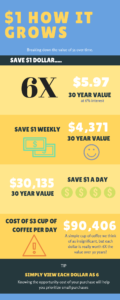Auto Depreciation, a sad reality when purchasing a new car. I get it, the new car smell, the fact that no one has used the car, and getting to be the only owner of the car. All those are great, but they come at a cost, sometimes significant it can be quite large.
Take a look at this auto depreciation info-graphic created by Edmunds:
In the first year on a $29K car, you can lose over $5K in value. That is a significant amount to lose on Depreciation alone. Here is what most people don’t understand however, the money you lose in the value of the car is built into the finance payments you are making. Why does that matter? Simple, each month you are making monthly payments where a portion of your payment does not contribute to anything but the loss in value of the car.
Remember the Thrifty Rich money mindset, small changes have large impacts over time. Let’s see just how large of an impact depreciation has on your overall financial well being.
Let’s make things simple. If you were to purchase a $29,000 car financed over 5 years at 0% interest, your payment would be $483.33 per month. Now, if we assume that the first year’s depreciation is $5,600, we can assume that you should be able to find the same car that is approximately one year old for $5K less than the new model putting your payment at $400 per month. (yes I know there may be some differences in interest rate between new and used. Simply use a payment calculator to plug in the real numbers to see the impact and to make the right choice. I use simple numbers here to illustrate what it can look like)
So in this example where interest rates are equal, you are paying $83.33 per month over five years for just the first year’s depreciation. That is a lot.
Let’s take that one step further to understand how that really impacts your financial savings. If you were going to buy the new car, I assume you could afford the $483.33 payment. If you buy the used car, you can make the $400 payment plus $83.33 per month paid to your investment savings account. If we assume a nominal return on the S&P 500 index fund SPY of 5%, your $83.33 per month becomes $5,650!
So instead of ending up with nothing at the end of 5-years, you end up with $5,650. That is a big swing. Additionally, you can now use the $5,650 plus the remaining value of your car to buy your next car, however, it may not be the best way to use your saved money since that savings is now large enough to start generating returns for you. Take a look at why investing is important to see begin your journey on investments.
Some additional depreciation resources and information
Here is a great tool to calculate depreciation.
From Bankrate: Decoding Depreciation
If you want to understand the finer points of depreciation, consider dusting off your college textbooks. “Ultimately, it comes down to what you learned in your Econ 101 class,” Ibara says.
“It’s supply and demand,” he adds. “The vehicles that hold their value best are the ones that have a strong demand when the vehicles are new.”
Besides age and mileage, Ibara and Montoya cite several other major factors that may help determine the rate of a car’s depreciation.
-
Supply. If consumer demand for a car outpaces supply, that will slow depreciation. Similarly, when fleets of rental cars are sold at auction, “it creates a bubble of supply, which tends to bring used-car rates down” for those models, Ibara says. “The vehicles that hold their value best are typically not vehicles you see in quantity at a daily rental [agency].”
-
Current auction prices. Remember: A car is worth only what people are willing to pay for it. “Transaction prices at auction will establish what your trade-in value will be when you sell your car,” Ibara says.
-
Incentives offered on newer models of your car. Big dealership incentives can be good news for your wallet when you buy new. But they may be bad news when you’re trying to sell your used car.
-
Location. In warmer weather states, cars tend to be in better shape, so they tend to be worth a little more, Montoya says.
-
Perception. Consumers perceive some vehicle makes and models as more reliable, desirable and valuable. And those perceptions can have a very real impact on depreciation, Montoya says.
Lastly, State Farm has this nice little calculator to help you compare new car vs. used car costs.
Buying a new car can have significant impacts on your financial savings. Always make sure to understand those impacts and find ways to minimize them. Sometimes the rebates, financing incentives, and other deals can offset the depreciation that you might have in the first year, other times there is no way to offset the cost and buying used is the better route. It is never a clear cut path and depends highly on a combination of the model and brand of the car, the incentives being offered, and the used market for that car.
Do your research and know your numbers to make sure you are making the best choice.
Post your comments below to let other’s know what you did and the analysis you went through to get the best deal!








